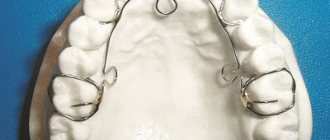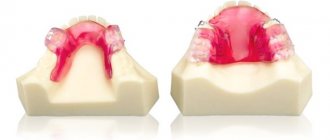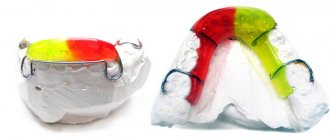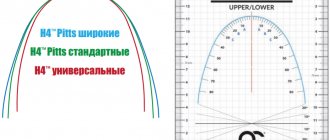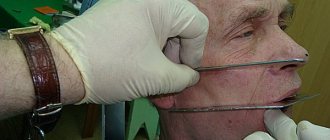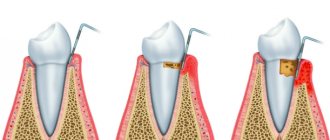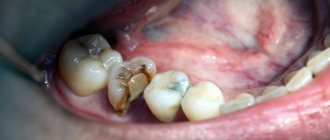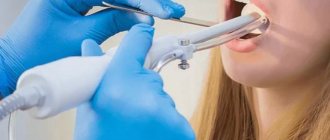The Frenkel appliance is one of the types of orthodontic appliances created to eliminate the problems of malocclusion, uneven teeth, and developmental deformities of the jaws in children.
This device allows parents from an early age to begin correcting congenital pathological disorders of the dentition (its use is allowed for children from 3-4 years old).
Features of the device design
The basis of the removable two-jaw apparatus is:
- complex metal frame;
- side (cheek) shields;
- lip pelota;
- loops for securing incisors and canines.
The frame is made of thin elastic wire, up to 1 mm in diameter, with three arcs:
- lingual;
- palatal;
- vestibular.
The arches are connected to plates made of plastic (less often metal); if necessary, screws and springs are additionally used to speed up the movement of certain teeth.
General overview
The Persin device for normalizing distal occlusion is a combined-action device, since it contains both elements of passive and active bite correction.
The device itself is a plate that is located on the hard palate, and an arched wire part is attached to it.
In the area of the front teeth, the arch bends, forming a spiral of half-loops. Thus, when the patient closes his jaws, the wire element promotes the advancement of the lower jaw and stimulates its active growth.
In addition, the device can be used to treat mesial occlusion. In this case, the device will be a monoblock structure located on two jaws.
A special feature of this device is the presence in the occlusal pads of imprints of the chewing surfaces of the lateral teeth of the upper jaw. This helps to fix its position in the device. There are no such imprints on the lower jaw, as a result of which the lower jaw has the ability to move distally.
The device straightens the dentition by redistributing the natural functional load from the muscles of the jaw, lips and cheeks.
Before the device is manufactured, the constructive bite is determined individually for each patient, and then a device is made that takes into account the individual characteristics of the particular patient.
While wearing the device, the doctor recommends performing certain exercises that can more effectively develop muscles and straighten the muscles of the face and jaw.
Sufficient use in the afternoon and during sleep. Within a few weeks to a month, the first positive changes appear, the bite of both lateral and front teeth improves.
The therapeutic effect of the device is carried out due to the activation of the lower vestibular arch, as well as the expanding effect of the mechanisms of the upper part.
Removing the plastic around the lower teeth allows the crooked areas to move and gradually move into the correct position.
The device allows you to bring other organs of the oral cavity, including the tongue, to a normal position, and it is possible to correct deviations that cause discomfort.
Purpose
Let's consider the Persin device, designed for the treatment of distal occlusion. This anomaly is characterized by pathological protrusion of the upper teeth in relation to the lower teeth when the jaws are closed.
The anomaly has the following symptoms:
- "Bird's face" The upper jaw protrudes forward, the chin is slanted.
- The upper lip is shortened, the lower lip sinks.
- The lower and upper frontal rows of teeth do not close, i.e., there is an enlarged sagittal gap.
Normally, the upper and lower incisors are in contact with each other, with the upper ones located in front of the lower ones by a size equal to the thickness of the cutting edge of the tooth.This corresponds to a sagittal gap of 2-3 mm. With significant anomalies, the sagittal fissure can reach sizes of 7-8 mm.
- The lateral teeth do not close together correctly. The upper molars are shifted forward relative to the lower ones.
- Speech, chewing, and swallowing may be impaired.
The cause of the defect is usually unfavorable conditions for the development of the child’s maxillodental apparatus in the prenatal and postnatal periods, including the nature of feeding.
The anomaly is normal for infants. When suckling at the mother's breast, the increased load on the baby's lower jaw causes it to grow and move forward. Thus, congenital ptology corrects itself.
This is interesting: If you suddenly swallowed a brace, what should you do?
With artificial feeding, the load on the lower jaw is reduced, so the anomaly remains uncorrected.
Rickets, diseases of the nasopharynx that cause mouth breathing, bad habits such as thumb sucking and some other factors contribute to the preservation and development of the anomaly.
In addition to the functional wire loop, the device has a labial pad that retracts the lower lip, thereby increasing the tone of the orbicularis oris muscle. Activation of the base arch also eliminates protrusion of the upper incisors.
There is also a modification designed to correct mesial occlusion - this device is put on two jaws, with the upper jaw being fixed with occlusal pads, and the lower jaw remaining mobile, due to which its muscles develop, which helps correct the bite.
In addition to external unattractiveness, deviations in the structure of the dentition create other problems:
- changes in the functioning of the jaw mechanism leads to an increase in defects in the teeth located behind. As a result, they deteriorate and break down faster;
- the risk of complete tooth loss due to gum problems increases;
- diseases of the jaw joints develop;
- dysfunction of the respiratory and digestive organs appears;
- Dental treatment using dentures is difficult.
Design and operating principle
The design is a palatal base made of a polymer plate with wire clasps, arches and a labial band attached to it.
The mechanism of action is based on the redistribution of the functional load between the dentition and an increase in the tension of the orbicularis oris muscle.
The vestibular arch of the system, on the one hand, eliminates the pathological protrusion (protrusion) of the upper incisors, on the other, it advances and stimulates the growth of the lower jaw. Lingual loops serve as a flap for the tongue.
Correction of the anomaly when wearing the device for a long time consists of the following changes:
- The lower jaw moves forward and is fixed in this position. This stimulates growth mainly in the area of the articular heads.
- The growth of the upper jaw is delayed.
- The work of facial and chewing muscles is normalized.
- The sagittal gap decreases.
- It makes it easier to close your lips.
- An obstacle is created to sucking and biting the lower lip, as well as the contact of the tip of the tongue with the lips, which ultimately normalizes breathing and swallowing.
Design features of the Persin apparatus for correcting mesial occlusion
The apparatus for correcting mesial occlusion has the following elements:
- base - made of plastic, placed on the lower jaw;
- Adams clasps are a type of clasps used exclusively for high-quality fixation of removable orthodontic products (including in dental prosthetics);
- vestibular arch - its metal part, located near the lower incisors, is covered with a vinyl chloride tube to prevent possible damage to the soft tissues of the patient’s oral cavity;
- protracting spring - made of metal wire, has U-shaped bends and is placed parallel to the vestibular arch on the inside of the upper incisors.
The orthodontic product prepared for installation is installed on the lower dental arch. When the dentition is compressed, the protracting spring exerts pressure on the inner (palatal) surface of the maxillary incisors. This action leads to its vestibular (external) movement.
Design features of the Persin apparatus for correcting distal occlusion
An orthodontic product consists of the following elements:
- palatal base plate - made of plastic;
- vestibular arch - fixed at the base and, when activated, preventing protrusion (tilting forward) of the upper dental crowns of the incisors;
- a symmetrically curved metal arc - made of wire with a diameter of 0.8 mm, having spiral-shaped turns and straight sections;
- lingual loops - in addition to the main task of serving as a tongue rest;
- labial pelota designed to abduct the lower lip.
This is interesting: Advantages and disadvantages of plates for straightening teeth
The structure is also assembled using an impression of the predicted bite.
By closing the teeth, the patient activates the orthodontic device, causing the arch wire to move the lower jaw forward, which promotes its growth. By its action, the labial pelot moves the load to another row of teeth, and the orbicularis oris muscles come into a state of increased tone.
Contraindications
There are absolute contraindications, in the presence of which it is strictly prohibited to use the device:
- Allergic reaction to materials used in production. In this case, there can only be one way out - the search for materials that will not be rejected by the patient’s body.
- Intolerance to the design is associated with physiological characteristics, while rejection can lead, among other things, to a gag reflex.
In addition to absolute prohibitions on the use of the device, there are restrictions of a relative nature, which can be lifted after therapeutic procedures.
This may include:
- Remission of indolent diseases;
- Various viral infections;
- Presence of tumors in the mouth;
- The presence of dental diseases associated with the appearance of defects in the enamel surface.
It is easier to eliminate anomalies of individual teeth or their rows and alveolar processes; it is more difficult to eliminate deviations in the jaw bones.
Correction of the anomaly and prognosis depend on the type of defect and the age of the patient. There are many types of distal occlusion depending on the size of the dental arches and the position of the teeth. According to the classification of Yu.M. Malygin, there are 9 of them, and not all of them can be cured using the Persin device or other similar designs .
For example, with micrognathia (reduced size of the lower jaw), the use of the Persin design gives good results. At the same time, with macrognathia (increased size of the upper jaw) and prognathia (anterior position of the upper jaw), it is better to use other corrective instructions - braces, crowns, rings, rubber rods.
In any case, indications and contraindications for a particular device or method of correcting dental anomalies are determined by the doctor on a purely individual basis.
Positive and negative aspects of treatment with the Persin apparatus
Advantages of the Persin device:
- the opportunity to rid the child of habits that, in part, could cause pathology;
- used during sleep and does not cause psychological discomfort to the patient;
- Hygienic care of the product is quite simple and does not require special skills.
Design disadvantages include:
- a long process of adaptation due to the intermittent use of the design;
- quite frequent visits to the dental office to activate the device.
Operating principle of the Frenkel apparatus
Most orthodontic structures have a mechanical effect on the dentition.
Frenkel developed an absolutely unique technique based on a functional effect on the regulation of muscle tone, with its help you can achieve the following results:
- reducing pressure on the cheeks and lips on the jaw in problem areas;
- positive effect on the activation of functions and natural functioning of the muscular tissues of the oral cavity;
- normalization of nasal breathing;
- the device promotes the desired position of the tongue, closing of the lips and thereby ensures the harmonious development and growth of the jaws of young patients.
Are there any contraindications
The device is ineffective for treating adults and patients in the later stages of development of the dental system.
Also, the effect of use will not be with other malocclusions - cross, deep and open.
Otherwise, the device has no contraindications - if a child is allergic to the materials from which the device is made, a hypoallergenic analogue is selected at the development stage.
Review of the design of the functional Frenkel apparatus and its purpose.
In this publication we will consider the stages of manufacturing the Engle apparatus.
Here https://orto-info.ru/sistemyi-vyiravnivaniya-zubov/lechebno-profilakticheskie-apparatyi/basharovoy.html we will find out what the Basharova apparatus does.
Indications for use of the Frenkel apparatus
The effective period for the treatment of children's dental pathologies is considered to be the time of their active growth (4 - 12 years).
An orthodontic appliance is used for the following pathologies:
- distal bite (strong development of the upper jaw);
- mesial bite (pushing forward of the lower teeth);
- open bite (the lower and upper dentitions do not meet, a gap is formed);
- neutral bite (insufficient development of alveolar processes);
- narrowing of the dentition;
- twisted teeth.
What to do when some kind of device is installed, and a child’s tooth falls out or begins to erupt?
You should definitely visit an orthodontist. If some teeth have erupted and are in the way, the orthodontist can file down the plastic or bend the wire. If this does not help, then you need to give it to a technician for re-milling. It is important to hand over the device quickly. It's bad when a month has passed. For example, we carried out diagnostics, ordered a device, and the child comes in a month or 2, because we went on vacation. If the device sits down, good, everyone is lucky. In 50% of cases it can be corrected, but it is better not to delay it for more than 2 weeks.
Examination before physiotherapy
The appearance of the slightest signs of abnormal development of teeth in a child obliges parents to seek advice from an orthodontist.
After a visual examination, the doctor will suggest:
- take an x-ray or orthopantomogram of the upper and lower jaw;
- cure carious teeth and inflammatory processes in the oral cavity, if any.
Based on the images, the doctor will determine the type of pathology and prescribe treatment with the appropriate type of device design to eliminate the defect.
What is the duration of orthodontic treatment?
Treatment may last depending on the stage at which the patient came to us.
- If he came to the orthodontist as a teenager, and the doctor entered the growth stage, when these functional devices still work well, then treatment can last about a year, followed by a retention period, when the patient is asked to wear the same device at night or is prescribed another suitable one so that the result treatment did not go away.
- If this is a small child, then treatment can last quite a long time. Many parents now agree to start treatment as early as possible and prevent the pathology, rather than wait for it to worsen and treat a more complex one.
Types of Frenkel apparatus
Different pathologies require different effects on the patient’s dental apparatus. There are four types of this design:
- FR - I is used to eliminate signs of distal occlusion with protrusion of the frontal teeth of the upper jaw, and with narrowing of the dentition. They consist of palatal and lingual arches, attached with upper and lower pelota. The cheek shields are connected to the lower pads using brackets. It is located in the oral cavity so that the shields do not come into contact with the alveolar ridge.
- FR-II is used to correct excessive inclination of the upper incisors (retrusion). It differs from the first type in the type of loop capes on the fangs and the presence of double pelotes. The shields are in close contact with the dentition and the crest of the alveoli. Made from transparent material.
- FR - III eliminates progeny (excessive development of the lower jaw). The design feature is the absence of lower pelotes and the presence of a vestibular arch.
- FR - IV corrects open bite, eliminates the reasons that hinder the development of the lower jaw. There are pads for the lower lip, a vestibular arch for the upper row, and metal pads. The device also helps to separate the bite.
How to motivate a child for treatment?
It is very important to properly motivate your child. If a child is not motivated, he will not wear anything. The orthodontist’s task is to explain that the child needs this, that he will be beautiful, that this is his future, that this is his smile.
In the practice of our orthodontists, children usually do not tell their parents honestly. Then the doctor asks the parents to leave. Children usually admit that they do not wear them all the time. There is always a reason in such situations. If they laugh at school, then you need to agree that the child wears it only at night and on weekends, when he does not go to school. But if this is unacceptable, then wear the device at night, at home, on weekends.
Rules and terms for using the Frenkel apparatus
In order for the treatment to be effective, the following rules and deadlines must be observed:
- The Frenkel apparatus is used at night and for a short time during the day (2-3 hours). During daytime treatment, it is forbidden to talk or eat food.
- It is imperative to carry out daily hygiene procedures for the oral cavity and orthodontic structure to avoid the development of caries.
- The duration of the treatment period is from 8 months to 1.5 years.
- Due to the intensive development of the child’s dental apparatus, the device changes 3-4 times during treatment.
Treatment process after consultation with an orthodontist
- After consultation, if we decide with the parents and child that treatment with functional equipment is indicated for us.
- The next stage is diagnosis.
- After diagnosis, we receive jaw models, all photographs, make all calculations, and take necessary photographs. This is usually a lateral radiograph and CT scan.
- We calculate and make the device. Either it will be an individual device, for example, a Frenkel device, which a technician makes, or it will be an elastopositioner, which we select from a line that is most suitable for a given child.
- We order the device, receive it in 1-2 weeks, call the patient and his parents for an appointment, hand over the device, give recommendations for wearing, care, and visits.
- A visit is recommended once a month; you need to talk and check how the child is wearing the device. Then we release him with the device for 2 months.
- Control examination once every 1-2 months. If the device requires some kind of activation, then it is done by the orthodontist.
Results after therapy with the Frenkel apparatus
The use of the Frenkel apparatus in eliminating deviations in the development of the dentition gives a good effect:
- eliminates the need for a surgical solution to the problem in later stages of the disease;
- Speech defects caused by dental pathologies are corrected.
- children get rid of bad habits (holding a finger, a pencil in the mouth).
- the effectiveness of treatment has a positive effect not only on the physical condition of the child, but also improves his appearance and psychological mood.
The Frenkel apparatus is actively used by orthodontists, is popular among patients and is considered a worthy alternative to the braces system.
Manufacturing process
The device is made on the basis of a two-jaw cast. The latter reflects the nature of the location of all teeth, alveolar processes and folds near the tongue. The final model is fixed in such a way that it forms the correct bite.
Based on the cast, the doctor determines the location of the side shields. These elements should not fit tightly to the dentition and alveolar processes. During the modeling process, wax is poured into the area where the side panels and caps will be located. The thickness of the former does not exceed 2.5 mm, the latter – 3 mm.
A special laboratory is engaged in manufacturing the base of the device. Metal arches are adjusted in the presence of the patient. The work on creating the Frenkel apparatus will be completed by polishing and grinding the plastic structural elements.
Reviews
There is a huge variety of dental anomalies. There is no universal way to correct incorrect teeth position that is suitable for all cases.
All the more valuable is any individual experience. If you have ever used a Persin or any other device to correct your bite, please share your impressions with other visitors to our site. Leave a comment at the bottom of this page.
If you find an error, please select a piece of text and press Ctrl+Enter.
Tags devices: bite correction
Did you like the article? stay tuned
No comments yet



